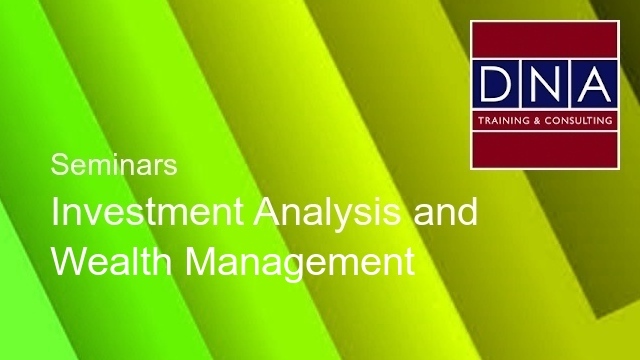Private wealth management is perhaps the fastest-growing area of the financial services industry worldwide.
Many institutions are devoting increased resources to the pursuit of this high- margin, low-capital business, where potential worldwide assets under management are estimated to exceed US$25 trillion. Nonetheless, the attractions of this market segment are matched by the demanding nature of the clientele and the complexity of its product and service needs.
This 4-day workshop is designed to equip participants with a framework for addressing those needs, including knowledge of the key product types that are of strong interest to the private investor. Delegates experience the implementation of a comprehensive, systematic approach to understanding what their clients are trying to accomplish in their investing lives and within what constraints.
This understanding of investment goals and constraints will then be translated into a strategic asset allocation the basic long-term portfolio structure for the client in question. The investment management process is then completed with implementation in a portfolio, within the context of a tactical view as to the near-term prospects for different asset class returns and risks. This process is complemented with a review of products likely to be of special interest to medium- and high- net-worth clients, including debt and equity products and basic derivative instruments. The role of alternative asset management products – real estate, hedge funds, and private equity – within a portfolio is also illustrated. Finally, attention is directed to the value of structured products –equity- and currency linked notes – in a portfolio.
Extensive use of case studies and group work will focus delegates on the practical aspects of portfolio construction and risk analysis. A material portion of the workshop is devoted to the review of key statistical concepts central to private wealth management.
Workshop Objectives :
- Equip delegates with a systematic approach to understanding PWM client investment goals and constraints
- Instill into delegates a solid grasp of statistical concepts central to the investment management process
- Combine that systematic approach with those statistical concepts in the development of strategic and tactical asset allocations for hypothetical PWM clients
- Familiarize delegates with the principal debt, equity and derivative investment products that play a critical role in PWM portfolios, including real estate, hedge funds, and private equity
- Develop familiarity with the pricing, mechanics, risks and applications of structured products in a PWM context
Workshop Outline
Introduction: Saving vs. Investing
- The Role of Banking Products in a Customer’s Portfolio
- Short-term Principal Preservation
- Liquidity Buffer, Cash Management
- Real Estate Financing: Mortgages
- The Role of Investment Products in a Customer’s Portfolio
- Long-term Capital Build -up
- Tradeoff of Potential Risk and Illiquidity for High Real Returns
- Role of the Fiduciary vs. Role of the Banker
- The Two Basic Approaches to Investing
- Active Management vs. Passive Management (Indexing)
Profiling/Needs Mapping – Customer Goals and Constraints
- Investment Goals
- Return Objectives; Current Income or Capital Gains
- Liquidity Needs: How Much Cash Do I Need On An Ongoing Basis?
- Tax Goals
- Types of Goals: Near-Term v. Long-Term goals, including home purchase, children’s education, retirement funding, vacation, charitable contributions
- Investment Constraints
- Current and Future Funds Flows Available for Investment
- Time Horizons
- Risk Profile: Aversion or Tolerance?
- Liquidity Needs
- Legal and Regulatory Hindrances
Profiling/Needs Mapping – Investor Lifecycle/Investor Attitudes Toward Risk
- Investor Life Cycles
- Accumulation Phase: Young Adulthood to Middle Age
- Consolidation Phase: Middle Age to Retirement
- Spending Phase: Retirement to Death
- Gifting Phase: Retirement to Death
- Attitudes Toward Risk – Variation with Age/Life Cycle Position
- Accumulation Phase: Modest Risk Tolerance
- Consolidation Phase: High Risk Tolerance
- Spending Phase: Low Risk Tolerance
- Attitudes Toward Risk – Variation with Profession
- Keeping in Mind the Total Portfolio
- Real estate, Autos and Other Large Durable Assets
- Insurance Coverage
- Cash Reserves
Translating the Customer Profile Into An Asset Allocation Strategy
- Realizing the Customer Profile Through Asset Allocation Decisions
- Defining Asset Classes: Non-Correlated Performance
- Combining Asset Classes to Balance Risk/Return Within the Client’s Risk Profile
- Conventional and Alternative Asset Classes and Sub-classes
- Determining An Optimal Allocation
The Portfolio Construction and Management Process
- The Process:
- The Process: Monitoring and Re -balancing
- Risk Reduction: Diversification
- Presentation of Proposed Starting Portfolio
Assessing Investment Success and Failure – Performance Measurement and Attribution
- Definition of Returns and Alternative Measurement Approaches
- Relative Performance Measures
- Versus an Index, Versus a Peer Group, Versus a Normal Portfolio
- Excess Returns
- Performance Attribution: Potential Sources of Excess Return
- Liquidity Issues, Problems with Data
Measuring and Managing Risk and Return for an Individual Holding and for a Portfolio
- Risk: Definitions
- Systematic (Undiversifiable) Risk
- Diversifiable Risk
- Risk: Alternative Measurement Approaches
- Standard Deviation of Returns
- Correlation with Some Benchmark – i.e. Betas
- Combining Risk and Return
- Coefficent of Variation: Standard Deviation/Average Return
- Sharpe Ratio
- Treynor Measure
- Diversification as Central Concept of Portfolio Construction
- Assessing Risk, Return and Correlations in the Portfolio Allocation
- Securities Selection in the Context of Diversification and Risk Reduction
Conventional Assets: Debt and Equity
- Debt Characteristics
- Debt Alternatives
- Equity Characteristics: Common and Preferred Stock
- Equity Alternatives: Mutual Funds, Closed-end Funds, Unit Trusts
- Passive Equity Products: Equity Index Unit Trusts and Closed-end Funds
Alternative Assets – Real Assets, Hedge Funds, Private Equity, Venture Capital
- The Definition of “Alternative”: Lack of Correlation in Price Performance
- The Role of Alternative Assets in a Diversified Portfolio
- Types of Alternative Assets
- Private Equity/Principal Investment Funds and Partnerships
- Commodity Assets (e.g., oil and gas partnerships)
- Equity Real Estate Funds and Partnerships
- Venture Capital Funds and Partnerships
- Hedge Funds
- Real Estate Investment Managers
- Venture Capital Partnerships and Their Managers
- Private Equity/Principal Investment Sponsors
- Commodity Trading Advisors and Commodity Partnerships
- Challenges with Alternative Assets
- Key Common Attributes of Hedge Funds
- Varieties of Hedge Funds: Management Approaches
- Direct Managers, Fund-of-Funds
- Varieties of Hedge Funds: Investment Strategies
- Long/Short (equitized and non-equitized)
- Quantitative (e.g. value/growth, momentum, dividend recapture, split and bounce plays)
- Arbitrage/Relative Value (e.g. cash/futures, convertibles, share class, index, volatility, credit spread, yield-curve, closedend, capital structure)
- Event-Driven (e.g. merger arbitrage, distressed, special situations)
- Other (e.g. macro, emerging markets, small cap)
Structured Products
- Options Fundamentals
- Review of terminology and taxonomy
- Payoff diagrams for single positions and combinations
- Directional and Volatility trading with options
- Intuitive pricing under Black-Scholes
- Zero -cost collars
- Put-Call Parity
- Caps, floors and their applications
- Basic Option Risk Management
- Delta and Gamma
- Vega and Theta
- Rho
- Creation and Customization of Structured Notes
- Understanding the customer’s risk/return appetite, maturity, credit profile, need for principal protection and minimum coupon
- Creating the principal guarantee
- Obtaining a minimum coupon
- Determining a maximum investor return
- Providing leverage
- Reducing the cost through averaging
- Reducing the cost by lowering the participation rate
- Reducing the cost by selling optionality to the issue
- Case Study: Equity-Linked Note
- Using Excel to construct and price the basic components
- Choosing among available alternatives
- Determining the leverage, cap, and payoff formula
- Determining sensitivity to equity price movements and vola tility
- Determining sensitivity to interest rate changes
- Determining sensitivity to passage of time
- Identifying the best and worst case scenarios
- Explaining the risks and rewards to customers
- Implementing changes to reflect customer feedback
- Measuring risk and performance
- Valuation in secondary market – components pricing
- Introduction to Exotic Options
- Barrier options
- Digitals and their uses
- Average rate options
- Lookbacks and ladders
- Best of and Worst of options
- Short case studies of structured notes with exotic options
- Suitability and Optimal Cosmetics
- What kind of customer is appropriate for what structured investment?
- How extensive does the risk disclosure have to be?
- Can historical performance simulations be misleading?
- What market conditions make what structures more attractive?
- Are any structures never suitable for any client?
- What are the legal and franchise risks?

